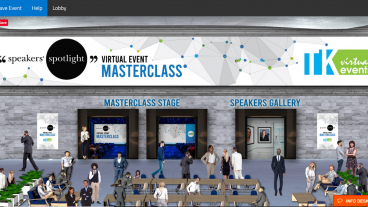Among the many things COVID-19 altered, how we conduct events is forever changed. Fully digital (and eventually hybrid) events have quickly become the industry standard, and this will likely continue even post-vaccine. People are as hungry as ever to learn and find inspiration, adapting quickly to the current circumstances. However, it can be difficult to deliver an impactful speech that inspires, educates and ultimately impacts the audience. Here’s what you need to know to deliver your message efficiently, and, remarkably.
My business, Speakers’ Spotlight, has booked more than 30,000 speaking engagements worldwide, with nearly 1,500 virtual speaking events since the pandemic began. Here’s what we’ve learned about the best practices in creating presentations that work in a digital setting.
Content is King
More than ever before, speakers must hone their content to focus on timely and relevant material developed with the intended audience in mind. Understand your audience and fully grasp the objectives of the event. Know the challenges the audience is undergoing and why they are looking to you to provide answers. Be certain your content is unique, timely, relevant and customized according to the needs of your audience. When using data such as statistics, case studies or currency, be sure to make them relatable to your audience based on location or business sector. When using visuals, do not use multiple sentences per page. Instead, use more images and include stories to illustrate your point or to inspire your audience.
Engagement and Interactivity are Musts
One-way conversations or monologues simply don’t work in this setting. Speakers need to engage with their virtual audiences, or the audiences will tune out or log off. Many platforms offer built-in survey or direct Q&A chat functions. Explore and take advantage of these systems to increase participation, and budget more time for Q&As and audience interaction. Your presentation can also be structured in different ways: first a keynote followed by Q&A; short 15-minute talks with Q&A in between, or only Q&A (fireside chat) with live questions that the moderator screens. There are many options. Increased interactivity allows people to feel more connected to the presenter and each other, helping to alleviate some of the isolation possibly felt in virtual presentation settings.
Don’t Shortchange Your Audiences
Attention spans may be shorter online, but audiences will remain engaged if the speaker and content are compelling. A 60-minute session still works. However, consider changing the rhythm from traditional keynote structures. One thing to keep in mind is the limit to how long audiences will stay with a virtual speech, and it is substantially shorter than a live one. While we find that up to an hour works, more than that takes special programming such as more interactivity.
Live is Better Than Pre-recorded
Whenever possible, we recommend presentations are delivered in real time. Our team has encountered very few technical issues, and the risk of a technology malfunction is far outweighed by the benefits of the live experience. The higher stakes of a live presentation help to secure the attention of the audience.
Not All Great Speakers are Great Virtual Speakers
While some of the talent and skills that work with in-person audiences transfer to the virtual world, some presentations simply don’t work as well virtually. Speakers may need to make changes to their presentations to connect with and impact their virtual audiences. Some speakers simply seem too awkward in front of a live camera whereas in person they are very charismatic. Speakers need to find the style that works best for them and their virtual presentations. Some of our speakers find they come across best standing up, a few interact with members of the audience, and one even rents out a theater with an entire crew to create a full experience (with no in-person audience, only a virtual audience). This is the time when you can get creative.
Technology Matters
Finally, here are a few quick notes on the technical aspects of presentations themselves.
- Find a presentation platform that works well for you and is also easily accessible for your audience. We conduct most of our events on Zoom, and it is familiar to most audiences.
- Good quality sound is priority No. 1. Visuals are important as well, but if the sound of your voice is unclear or distorted people will quickly tune you out or leave the presentation entirely. Test your microphone and software and adjust as necessary.
- Regarding visuals, individual approaches can vary. Some speakers are very visually driven, referencing a lot of content (images, graphs, videos, etc.) on their slides, while some do a fantastic job speaking directly to the audience without any visual aids.
The Future of Events
Digital events became a necessity because of COVID-19 and the related restrictions, but I believe they are here to stay in some form. Most likely, a hybrid of digital and live components to events and conferences will emerge. Organizers are witnessing the benefits of digital events. It is less expensive as there are no hotel rooms, meals, flights, etc.; it saves time (no travel needed); there is massive reach (more attendees than ever before); there is flexibility (the event can be structured in many different ways); and it is data-driven (easy to collect feedback on sessions and overall experiences as well as registration and tracking).
But digital alone is simply not enough. We all crave social interaction — whether to learn, be inspired or simply laugh. Events will never go away, but they will continue to evolve. There will be an element in person (perhaps for the senior management team and those who report to them directly) and a virtual component will be available online (maybe to their associates in other countries).
As our world continues to change and the uncertainty grows, that need for connection to one another has never been more important. While conferences, education, sporting events and so much of our society is happening virtually, effective communication online can not be underestimated. From a CEO to a teacher, and from a politician to a doctor, the need to understand how to make presentations work online has never been greater. We will continue to gather, to learn and be inspired as a group. I personally cannot wait to do that in person and perhaps watch some part of the event later at home on my computer.
This article, written by Speakers’ Spotlight CEO and Co-Founder Farah Perelmuter, originally appeared in the CEO Insights magazine of the Young Presidents’ Organization.




